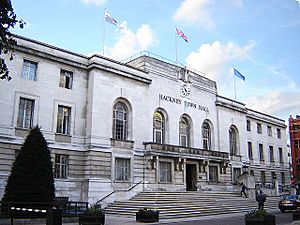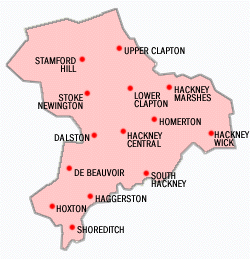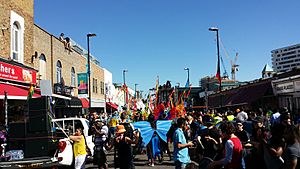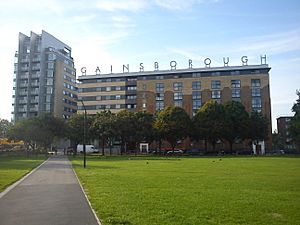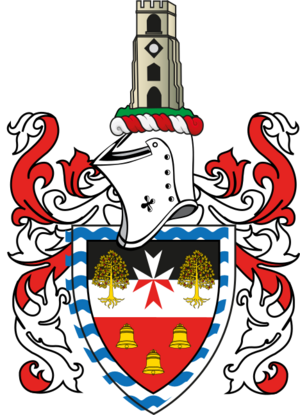London Borough of Hackney facts for kids
Quick facts for kids
Hackney
|
|||
|---|---|---|---|

Hackney from the air
|
|||
|
|||
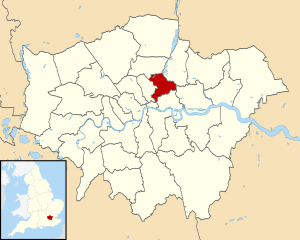
Hackney shown within Greater London
|
|||
| Sovereign state | United Kingdom | ||
| Constituent country | England | ||
| Region | London | ||
| Ceremonial county | Greater London | ||
| Created | 1 April 1965 | ||
| Admin HQ | Mare Street, Hackney | ||
| Government | |||
| • Type | London borough council | ||
| • Body | Hackney London Borough Council | ||
| Area | |||
| • Total | 7.36 sq mi (19.06 km2) | ||
| Area rank | 321st (of 326) | ||
| Population
(2020)
|
|||
| • Total | 281,120 | ||
| • Rank | 51st (of 326) | ||
| • Density | 38,200/sq mi (14,749/km2) | ||
| Time zone | UTC (GMT) | ||
| • Summer (DST) | UTC+1 (BST) | ||
| Postcodes |
E, EC, N
|
||
| ONS code | 00AM | ||
| GSS code | E09000012 | ||
| Police | Metropolitan Police | ||
The London Borough of Hackney is a part of Inner London, England. It's located about 5 kilometres (3 miles) north-east of Charing Cross, a central point in London. The borough gets its name from Hackney, which is its main area.
Some parts of Hackney are seen as part of East London, including areas that were traditionally in the East End of London. Other parts in the northwest are considered North London. Around 281,120 people live in Hackney.
The Greater London Authority (GLA) groups London boroughs into sub-regions. Hackney is currently part of the 'East' sub-region. The modern borough was formed in 1965. It was created by joining the old boroughs of Hackney, Stoke Newington, and Shoreditch.
Hackney shares borders with several other London boroughs. These include Islington to the west and Haringey to the north. To the north-east is Waltham Forest, and to the east is Newham. Tower Hamlets is to the south-east, and the City of London is to the south-west. Hackney was one of the host boroughs for the 2012 Summer Olympics. Some of the Queen Elizabeth Olympic Park venues are located within its boundaries.
Contents
History of Hackney
Where the Name Hackney Comes From
The name Hackney appeared as Hackenaye or Hacquenye in the 1200s. The exact meaning isn't fully known. However, the "ey" part likely means "island."
One idea is that Hackney means "Haka's island," named after a local person called Haka. This "island" would have been a place surrounded by marshes near the River Lea. The area used to be much wilder than it is today.
Another idea is that "Hack" could come from an Old English word meaning "hatch" (an entrance to a woodland). Or it could come from "Haca," meaning a hook, referring to a bend in the river. Given the "island" idea, "Haka's Island" or "Island on the bend" seem more likely.
The name Hackney first referred to this island or the land around it. Later, it was used for the entire ancient area of Hackney.
From Iron Age to Anglo-Saxon Times
During the Iron Age and Roman times, the River Lea was a border. It separated the lands of the Catuvellauni people to the west from the Trinovantes to the east. The Romans built a major road called Ermine Street. This road still runs through the modern borough today, known as Shoreditch High Street and Kingsland Road.
In the Anglo-Saxon period, the River Lea continued to be a boundary. It separated the lands of the East Saxons (on the east side) from the Middle Saxons (on the Hackney side). This natural border likely continued because different Saxon groups took control of already defined areas.
After Alfred the Great took control of both areas, the river became the border between the historic counties of Middlesex (Hackney) and Essex.
Later History of the Area
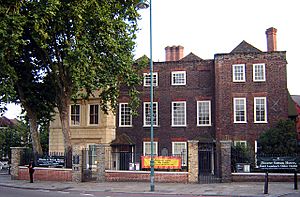
During the Tudor era, the Crown took land from religious groups and sold it. Hackney became a popular country retreat for rich people. King Henry VIII even had a palace near where BSix Sixth Form College is today.
Sutton House, built in 1535, is the oldest surviving home in Hackney. It was originally called Bryck Place. The village of Hackney thrived as a rural escape until the late Georgian period.
The first "hackney coach" (a type of taxi) started in London in 1621. Many people believe the name "hackney" for a London taxi comes from the village name. Hackney was known for its horses and horse-drawn carriages.

The first Tudor theatres in London were built in Shoreditch. The famous Gunpowder Plot was first discovered near Hoxton.
In 1727, writer Daniel Defoe noted how much Hackney had grown. He said it was filled with buildings and people, and that "Every separate hamlet is encreas'd". He also mentioned that many wealthy citizens lived there, keeping "near a hundred coaches".
The parish church of St John-at-Hackney was built in 1792. It replaced an older church from the 1500s. Many famous people lived in Hackney during the 17th, 18th, and 19th centuries. These included Robert Aske and Joseph Priestley.
Stoke Newington and Stamford Hill had many grand houses. Stamford Hill became a centre for Hackney's Jewish residents from the 1930s. Director Alfred Hitchcock made many of his early films in Hoxton.
After World War II, many new homes were built. The population of Hackney has become very diverse due to immigration. Many old Georgian and Victorian houses are being restored. Old warehouses are being turned into homes, and new flats are being built.
In the 1980s, Hackney was sometimes called the poorest borough in Britain. This has changed a lot. In 2019, Hackney was ranked the 22nd most deprived borough in England. This is much lower than its 2nd place ranking in 2010. Hackney is now often discussed in terms of gentrification, which means an area becomes more expensive and attracts wealthier residents.
Hackney is known as inner London's "greenest borough." It has 62 parks and open spaces, covering about 330 hectares (815 acres). Seven of Hackney's parks have won the Green Flag award. Hackney Marshes has the largest collection of football pitches in Europe. Part of it was used for the 2012 London Olympics.
Historic Buildings and Protected Areas
Hackney has 1,300 listed buildings. These include the Hackney Empire theatre and the Tudor-era Sutton House. The oldest building in the borough is the Grade I listed medieval St Augustine's Tower.
The borough also has 25 conservation areas. These areas protect important historic places like Clapton Square and Clissold Park. They also protect large areas of Georgian and Victorian homes, and places important to industrial history.
How Hackney Was Governed Over Time
The area of modern Hackney roughly matches three old church areas: Hackney, Shoreditch, and Stoke Newington. These areas were part of the Ossulstone hundred in Middlesex county.
From 1856, the Metropolitan Board of Works governed London. In 1889, this area became the County of London. Local government was handled by parish vestries and district boards. Shoreditch had its own vestry. Hackney and Stoke Newington were first grouped together.

However, Stoke Newington didn't like being grouped with Hackney. So, in 1894, they separated and each had their own vestry.
In 1900, these local areas became metropolitan boroughs. Hackney, Shoreditch, and Stoke Newington each became their own borough. Shoreditch also took in a small part of the Liberty of Norton Folgate.
Stoke Newington was quite small. There were ideas to merge it with Hackney again, but people remembered the "intolerable and interminable feuds" from before. So, it was decided to merge Stoke Newington with a part of Hornsey called South Hornsey. This made Stoke Newington a bit bigger, even though it was still one of London's smaller boroughs.
The current London Borough of Hackney was created in 1965. It brought together the areas of the three former metropolitan boroughs: Hackney, Shoreditch, and Stoke Newington.
How Hackney is Governed Today
The local government for Hackney is called Hackney Council. They meet at Hackney Town Hall. Since 2002, the council has been led by a directly elected Mayor of Hackney. A "Speaker" handles the official and ceremonial duties, like a non-political mayor.
London-Wide Representation
For elections to the London Assembly, Hackney is part of the North East area. Sem Moema is the elected Assembly Member for this area since 2021.
UK Parliament Representation
Hackney has two areas for the UK Parliament: Hackney North and Stoke Newington and Hackney South and Shoreditch. Both areas are represented by Members of Parliament (MPs) from the Labour Party: Diane Abbott and Meg Hillier.
Geography of Hackney
Neighbourhoods in Hackney
The London Borough of Hackney was formed by joining the old areas of Hackney, Shoreditch, and Stoke Newington. These areas have been defined for many centuries. The River Lea has historically been the border between Middlesex and Essex counties.
Within these main areas are many smaller neighbourhoods. These smaller areas are usually based on old villages that grew and merged as the city expanded. They don't have official borders, but people generally know where they are.
The area of old Stoke Newington includes Woodberry Down. The old area of Shoreditch includes Hoxton and Haggerston.
The old area of Hackney is much larger. It includes places like Hackney Central, Dalston, Stamford Hill, London Fields, Upper and Lower Clapton, Hackney Wick, and Homerton.
Land and Rivers
The London Borough of Hackney covers about 19 square kilometres (7.4 square miles). The land rises from the River Lea in the east to about 30 metres (98 feet) above sea level in areas like Clapton Common.
After the Norman Conquest, the area became part of the Forest of Middlesex. However, "Forest" here meant royal hunting rights, not necessarily lots of trees. By the 1700s, the area was mostly farmland with small villages and few woods. Many of the main roads we see today were already there.
The biggest changes have been to the rivers and wetlands. The River Lea is the main natural feature. Its marshy areas are gone, and the River Lee Navigation was created in 1770. This is an artificial channel that goes through Hackney Cut and across the Hackney Marshes. In Roman times, the River Lea was a tidal estuary, meaning the sea's tides reached as far as Hackney Wick.
The Hackney Brook used to meet the Lea at Hackney Wick. This meeting point was very wide when flooded. The Hackney Brook was put into underground pipes in 1860.
The New River was opened in 1613. It brought drinking water to London from the Lea area. It still flows through Hackney today, near Finsbury Park. Another man-made waterway, the Regents Canal, also crosses the south of the borough. It joins the Hertford Union Canal near Victoria Park.
Homes and Businesses
Much of Hackney still feels like an inner-city area. However, in places like Dalston, large housing estates now stand alongside new gated communities. In South Hackney, near Victoria Park, you can still find terraced homes from the Georgian, Victorian, and Edwardian periods.
Light industries near the River Lea employ over 3,000 people.
Geology and Climate
The Lea and Hackney Marshes have alluvium soils. The higher ground between Homerton and Stamford Hill is made of London Clay. Hackney's climate is similar to the rest of London.
Population and People
| Population | ||
|---|---|---|
| Year | Pop. | ±% |
| 1801 | 14,609 | — |
| 1811 | 19,523 | +33.6% |
| 1821 | 25,342 | +29.8% |
| 1831 | 35,482 | +40.0% |
| 1841 | 68,246 | +92.3% |
| 1851 | 94,961 | +39.1% |
| 1861 | 172,385 | +81.5% |
| 1871 | 249,810 | +44.9% |
| 1881 | 327,234 | +31.0% |
| 1891 | 369,209 | +12.8% |
| 1901 | 374,132 | +1.3% |
| 1911 | 379,120 | +1.3% |
| 1921 | 368,469 | −2.8% |
| 1931 | 358,117 | −2.8% |
| 1941 | 305,501 | −14.7% |
| 1951 | 260,626 | −14.7% |
| 1961 | 240,521 | −7.7% |
| 1971 | 221,975 | −7.7% |
| 1981 | 179,536 | −19.1% |
| 1991 | 187,792 | +4.6% |
| 2001 | 202,819 | +8.0% |
| 2011 | 246,270 | +21.4% |
| 2021 | 259,147 | +5.2% |
| Source: A Vision of Britain through time | ||
In 1801, the areas that now make up Hackney had about 14,609 people. This number grew steadily in the 1800s as the area developed. By the mid-1800s, it reached 95,000. When railways arrived, the population grew even faster, reaching almost 374,000 by 1900.
The population peaked before World War I. It then slowly fell until World War II, when many people moved out of London. The population is now rising again. The 2021 census showed Hackney's population at 259,147.
Hackney has a very diverse population. In 2001, about 44% of residents were White British. Other large groups included Black or Black British (24%) and Asian or Asian British (9%). There is also a large Turkish and Kurdish community, especially in north and central Hackney.
In 2018, about 36.4% of the population was White British. Other large groups included "Other White" (18.1%), Black African (10.3%), and Black Caribbean (6.4%).

Christianity is the largest religion in Hackney, with 30.7% of residents identifying as Christian in 2021. About 13.3% are Muslim, and 6.7% are Jewish. Hackney has the second-largest Jewish population of any local authority in the UK.
In 2007, a report showed that many children in Hackney lived in low-income households. In the 2011 census, Hackney had the highest rate of people cycling to work in London.
Education in Hackney
Hackney Council is responsible for education in the borough. They oversee over 70 schools, nurseries, and play centres. Hackney has some very successful City Academies. There are also plans to rebuild or improve every other school in Hackney.
Public Libraries
The London Borough of Hackney has eight public libraries:
- Clapton Library
- Dalston CLR James Library
- Hackney Central Library
- Homerton Library
- Shoreditch Library
- Stamford Hill Library
- Stoke Newington Library
- Woodberry Down Library
Transport in Hackney
Three London Overground train lines serve Hackney. The North London Line runs from west to east. The East London Line runs from north to south. The Lea Valley Lines also have local services.
It is planned that a future train line called Crossrail 2 will have a new station in Dalston. There might also be future stops at Hackney Central and Hackney Wick.
London Overground Stations
- North London Line: Dalston Kingsland, Hackney Central, Homerton, and Hackney Wick.
- East London Line: Dalston Junction, Haggerston, Hoxton, and Shoreditch High Street.
- Lea Valley Lines: London Fields, Hackney Downs, Rectory Road, Stoke Newington, and Stamford Hill.
How People Travel to Work
In 2011, the most common ways residents travelled to work were:
- Bus, minibus, or coach: 16.9%
- Underground, metro, light rail, tram: 9.2%
- Bicycle: 9.2%
- On foot: 7.5%
- Driving a car or van: 7.1%
- Train: 4.6%
- Working from home: 3.5%
About 65% of households in Hackney do not own a car.
Media
The Hackney Gazette provides local news for the area.
Attractions and Institutions
- Abney Park Cemetery – An old Victorian cemetery and nature reserve.
- Arcola Theatre – A studio theatre.
- Broadway Market – A popular outdoor market.
- Cafe Oto – A music club and café.
- Geffrye Museum – A museum about decorative arts.
- Happy Man Tree – England's Tree of the Year 2020.
- Hackney Empire – A famous theatre.
- Hackney City Farm – A city farm where you can see animals.
- Hackney Carnival – A colourful street parade.
- Hoxton Hall – A community centre and performance space.
- National Centre of Circus Arts – A school for circus skills.
- Newington Green Unitarian Church – London's oldest nonconformist place of worship.
- Rio Cinema – A historic Art Deco cinema.
- St John's Hoxton – An Anglican church.
- Shoreditch Town Hall – A historic town hall.
- Sutton House – A historic house and museum.
- Victoria Miro Gallery – A gallery for modern art.
- Vortex Jazz Club – A place to hear live jazz music.
- Woodberry Wetlands – A nature reserve.
- St Leonard's Hospital, Hackney – A local hospital.
Coat of Arms
The borough's coat of arms includes symbols from its three older boroughs:
- The shield has a picture of Hackney's St. Augustine's Tower.
- An eight-pointed Maltese Cross for Hackney. This comes from symbols of the Knights Templar and Knights of St. John, who once owned land in Hackney.
- Bells for Shoreditch. These are the bells from the nursery rhyme "Oranges and Lemons".
- Oak trees for Stoke Newington. They represent its history as part of the Forest of Middlesex.
Twin Towns
Hackney is twinned with:
 Austin, United States
Austin, United States Haifa, Israel
Haifa, Israel St. George's, Grenada
St. George's, Grenada Suresnes, France
Suresnes, France
Images for kids
See also
 In Spanish: Hackney para niños
In Spanish: Hackney para niños



